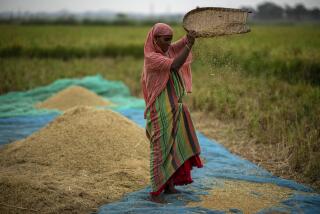COMMODITIES : Drought Sends Grain Prices Up, Meat Down
- Share via
Grain and soybean prices shot up the daily maximum Wednesday, while livestock and meat futures fell their limits as the drought continued to weigh heavily on the nation’s commodities markets.
Worries about crop shortfalls spurred the latest rise in grain prices, while livestock traders feared their market could be flooded if herds had to be reduced extensively because of feed shortages.
On other markets, cotton futures soared, energy futures slumped, precious metals advanced and stock index futures rose slightly.
Nearly all contracts for future delivery of grains, soybeans and soybean products shot up their daily limits early in the session on the Chicago Board of Trade.
Fears of drought damage to corn and soybean crops deepened as a band of showers moving into Illinois and Indiana weakened and produced only scattered sprinkles, analysts said.
The drought has begun to take a toll on the corn crop and could reduce soybean yields if it continues into July, analysts said. Oat and spring wheat crops already have suffered irreversible damage.
“I’m having a little trouble quantifying the worst drought in 60 years--I’m only 30 years old,” said Steve Freed, an analyst with Dean Witter Reynolds Inc. in Chicago. “We’re looking at the potential worst drought, the worst disaster in history.”
Higher Limit for Corn
After the close, the National Weather Service issued a new 6-to-10-day forecast calling for below-normal rainfall in the Grain Belt in the middle and latter portions of next week.
The Board of Trade announced after the close that it was raising the daily price limit on corn futures from 10 cents to 15 cents a bushel.
The higher limit will remain in effect for at least three sessions in accordance with exchange rules, which require a 50% increase in limits following two consecutive days of maximum price moves. Corn futures also rose the maximum on Tuesday.
Wheat settled 12 cents to 20 cents higher, with the contract for delivery in July at $3.94 a bushel; corn was 10 cents higher across the board, with July at $2.795 a bushel; oats also were 10 cents higher in all contracts, with July at $2.7925 a bushel, and soybeans were 27 cents to 30 cents higher, with July at $9.20 a bushel.
Many livestock and meat futures plunged their daily limits on the Chicago Mercantile Exchange, where traders feared the high cost of feed grains would prompt widespread liquidation of cattle and hog herds if the dry weather continued.
Livestock producers already have begun reducing their herds by sending more animals to market, which increases the supply of meat, said Chuck Levitt, an analyst with Shearson Lehman Hutton Inc. in Chicago.
But widespread herd liquidation this year would be followed by tight supplies of meat--and sharply higher prices--next year because of a corresponding drop in births, Levitt said.
“The factors that are driving the grain and soybean complex higher are the same exact factors forcing the livestock markets lower,” he said. “You are creating a catastrophic situation as far as the herd is concerned by continuing this drought.”
Cotton Futures Higher
Cattle and hog futures are limited to daily moves of 1.50 cents a pound, and frozen pork belly futures have a 2-cent limit.
Live cattle settled 1.50 cents lower to 0.05 cent higher, with the June delivery contract at 70.30 cents a pound; feeder cattle were 1.50 cents lower across the board, with August at 71.77 cents a pound; hogs were 1.50 cents lower to 0.55 cent higher, with June at 49.15 cents a pound, and frozen pork bellies were 1.72 cents to 2 cents lower, with July at 44.47 cents a pound.
Dry-weather fears also propelled most cotton futures up the daily limit of 2 cents a pound on the New York Cotton Exchange. July cotton settled 2 cents higher at 68.91 cents a pound.
Energy futures fell sharply on the New York Mercantile Exchange in a reversal of Tuesday’s gains.
Analyst Robert Baker of Prudential-Bache Securities Inc. said the swing reflected uncertainty whether members of the Organization of Petroleum Exporting Countries would abide by their crude oil production quotas.
West Texas Intermediate crude oil settled 30 cents to 35 cents lower, with the July contract at $16.53 a barrel; heating oil was 0.54 cent to 1.06 cents lower, with July at 43.42 cents a gallon, and unleaded gasoline was 0.30 cent to 0.95 cent lower, with July at 49.23 cents a gallon.
Gold and silver futures advanced on New York’s Commodity Exchange in reaction to the soaring grain prices, but gains were limited by the drop in crude oil prices, the strength of the dollar and a smaller-than-expected rise in retail sales last month, analysts said.
Gold settled $1.20 to $1.50 higher, with the August contract at $455.80 an ounce; silver was 8.5 cents to 8.9 cents higher, with July at $7.155 an ounce.
Stock index futures rose slightly on the Chicago Mercantile Exchange. The contract for June delivery of the Standard & Poor’s 500 index settled 0.20 point higher at 274.80.
Tables, Page 10
More to Read
Inside the business of entertainment
The Wide Shot brings you news, analysis and insights on everything from streaming wars to production — and what it all means for the future.
You may occasionally receive promotional content from the Los Angeles Times.










